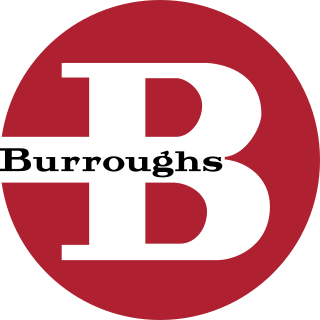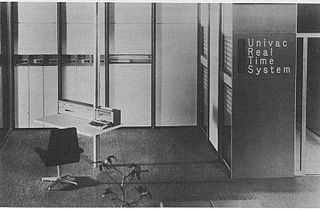
The Burroughs Corporation was a major American manufacturer of business equipment. The company was founded in 1886 as the American Arithmometer Company by William Seward Burroughs. In 1986, it merged with Sperry UNIVAC to form Unisys. The company's history paralleled many of the major developments in computing. At its start, it produced mechanical adding machines, and later moved into programmable ledgers and then computers. It was one of the largest producers of mainframe computers in the world, also producing related equipment including typewriters and printers.

A mainframe computer, informally called a mainframe or big iron, is a computer used primarily by large organizations for critical applications like bulk data processing for tasks such as censuses, industry and consumer statistics, enterprise resource planning, and large-scale transaction processing. A mainframe computer is large but not as large as a supercomputer and has more processing power than some other classes of computers, such as minicomputers, servers, workstations, and personal computers. Most large-scale computer-system architectures were established in the 1960s, but they continue to evolve. Mainframe computers are often used as servers.

In computing, time-sharing is the sharing of a computing resource among many tasks or users. It enables multi-tasking by a single user or enables multiple-user sessions.

Unisys Corporation is an American multinational information technology (IT) services and consulting company founded in 1986 and headquartered in Blue Bell, Pennsylvania. The company provides digital workplace, cloud applications & infrastructure, enterprise computing, business process, AI technology and data analytics services.

The UNIVAC I was the first general-purpose electronic digital computer design for business application produced in the United States. It was designed principally by J. Presper Eckert and John Mauchly, the inventors of the ENIAC. Design work was started by their company, Eckert–Mauchly Computer Corporation (EMCC), and was completed after the company had been acquired by Remington Rand. In the years before successor models of the UNIVAC I appeared, the machine was simply known as "the UNIVAC".

UNIVAC was a line of electronic digital stored-program computers starting with the products of the Eckert–Mauchly Computer Corporation. Later the name was applied to a division of the Remington Rand company and successor organizations.

The UNIVAC 1100/2200 series is a series of compatible 36-bit computer systems, beginning with the UNIVAC 1107 in 1962, initially made by Sperry Rand. The series continues to be supported today by Unisys Corporation as the ClearPath Dorado Series. The solid-state 1107 model number was in the same sequence as the earlier vacuum-tube computers, but the early computers were not compatible with their solid-state successors.

FIELDATA was a pioneering computer project run by the US Army Signal Corps in the late 1950s that intended to create a single standard for collecting and distributing battlefield information. In this respect it could be thought of as a generalization of the US Air Force's SAGE system that was being created at about the same time.

The UNIVAC 490 was a 30-bit word magnetic-core memory machine with 16K or 32K words; 4.8 microsecond cycle time made by UNIVAC. It was a commercial derivative of the instruction set that had been developed for the AN/USQ-17 by Seymour Cray for the US Navy. This was the last machine that Cray designed before leaving UNIVAC to join the early Control Data Corporation.

In computer architecture, 36-bit integers, memory addresses, or other data units are those that are 36 bits wide. Also, 36-bit central processing unit (CPU) and arithmetic logic unit (ALU) architectures are those that are based on registers, address buses, or data buses of that size. 36-bit computers were popular in the early mainframe computer era from the 1950s through the early 1970s.
The Symbolic Stream Generator is a software productivity aid by Unisys for their mainframe computers of the former UNIVAC 1100/2200 series.
Sabre Global Distribution System, owned by Sabre Corporation, is a travel reservation system used by travel agents and companies to search, price, book, and ticket travel services provided by airlines, hotels, car rental companies, rail providers and tour operators. Originally developed by American Airlines under CEO C.R. Smith with the assistance of IBM in 1960, the booking service became available for use by external travel agents in 1976 and became independent of the airline in March 2000.
A transaction processing system (TPS) is a software system, or software/hardware combination, that supports transaction processing.
LINC is a fourth-generation programming language, used mostly on Unisys computer systems.
MAPPER Systems, now known as Business Information Server, BIS, is a fourth-generation programming language originally from Sperry Univac. Now owned by Unisys Corporation. Mapper originated in the 1970s based on some work in the 1960s, It has been functionally enhanced and kept current. It was also given an extension named ICE - Internet Commerce Enabler.
Airline reservation systems (ARS) are systems that allow an airline to sell their inventory (seats). It contains information on schedules and fares and contains a database of reservations and of tickets issued. ARSs are part of passenger service systems (PSS), which are applications supporting the direct contact with the passenger.
ED or ED-1100 is an interactive text editor implemented on the UNIVAC 1100/2200 series.
"ED was developed at Univac in the mid-60s. It was loosely based on the Project MAC editor developed for the MULTICS system at MIT."-Tom McCarthy
"Project MAC editor was programmed by Jerry Saltzer as a way to produce documentation. In fact, that editor became the first interactive word-processor ever programmed."
"The command TYPSET is used to create and edit 12-bit BCD line-marked files"
OS 2200 is the operating system for the Unisys ClearPath Dorado family of mainframe systems. The operating system kernel of OS 2200 is a lineal descendant of Exec 8 for the UNIVAC 1108 and was previously known as OS 1100. Documentation and other information on current and past Unisys systems can be found on the Unisys public support website.
OS 2200 has had several generations of compilers and linkers in its history supporting a wide variety of programming languages. In the first releases, the Exec II assembler (SLEUTH) and compilers were used. The assembler was quickly replaced with an updated version (ASM) designed specifically for the 1108 computer and Exec 8 but the early compilers continued in use for quite some time.








